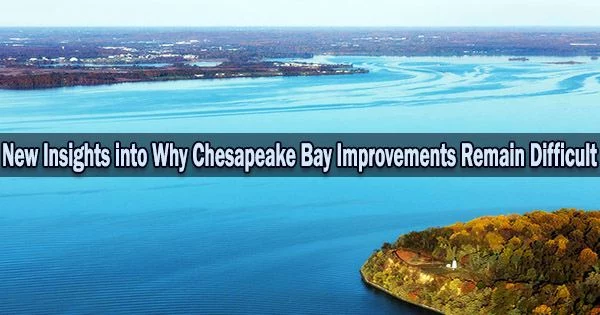The Chesapeake Bay is facing challenges in terms of improving water quality due to several factors such as population growth, urbanization, and agricultural practices in the watershed area, which increase the amount of pollutants entering the bay.
The response of the estuary to nitrogen reduction initiatives and the reasons why improvements have remained a key issue are clarified by a fresh look at the past of water quality in the Chesapeake Bay. Additionally, inadequate infrastructure for sewage and stormwater management can also contribute to the bay’s degradation.
There is a pollution threshold after which it takes twice as much effort to make a change, according to the University of Maryland Center for Environmental Science researchers who examined the Bay’s historical response to efforts to reduce nutrients to minimize dead zones areas with too little oxygen to support marine life.
“Once nutrient pollution crosses a threshold and the system enters a eutrophic state, it will take a much larger reduction to return to the original state,” said study co-author Ming Li, a professor at the University of Maryland Center for Environmental Science.
Low-oxygen areas of the bay, sometimes known as “dead zones,” are brought on by excessive nutrient contamination, largely from wastewater and agriculture. The extra nutrients cause an overabundance of algae, which settles to the bottom and breaks down in the water, using oxygen.
The term for this is eutrophication. The bay’s crabs, oysters, and other fisheries are in danger because the low oxygen levels that ensue are insufficient to maintain the majority of marine species and ecosystems in near-bottom waters.
Increasing nutrient pollution has been connected to expanding dead zones over the years, but this work shows that the system only reacts to reductions until the quantity of pollution reaches a specific threshold, at which point it requires twice as much effort to detect a difference.
Once nutrient pollution crosses a threshold and the system enters a eutrophic state, it will take a much larger reduction to return to the original state.
Professor Ming Li
“As a result, the Chesapeake Bay has become recalcitrant to changes in nutrient loads, and larger reductions would be required to induce a complete reversal of eutrophication-induced hypoxia,” said Li. “This may partly explain the modest reduction in Chesapeake Bay hypoxia since the implementation of nutrient management strategies in the mid-1980s.”
This study looked at the growth of low-oxygen areas between 1950 and 1989, a period during which the nitrogen pollution in the Chesapeake Bay doubled. Previous research demonstrated a relationship between elevated nutrient contamination from rivers and the significant spread of hypoxia during the 1950s and 1980s.
A complex interplay of several physical and biogeochemical processes leads to hypoxia, and additional factors may also be at play. It’s possible that the Bay’s bottom habitats, including those of oysters and underwater grasses, have modified the estuary’s ability to filter nutrients and silt.
Key baselines affecting the operation of coastal systems and their reactions to eutrophication may be altered as a result of the effects of climate change since 1989, including warming, sea level rise, changing precipitation patterns and river flows, along with associated changes in nutrient runoffs.
“Looking into the future, nutrient reduction strategies will need to be considered in the face of accelerated warming and sea level rise in the 21st century,” said Li.
This research was made possible with financial support from the National Science Foundation and the NOAA Ocean Acidification Program.
“What drove the nonlinear hypoxia response to nutrient loading in the Chesapeake Bay during the 20th century?” was published in Science of the Total Environment by Wenfei Li and Ming Li of the University of Maryland Center for Environmental Science.
Since the 1920s, scientists at the University of Maryland Center for Environmental Science have been at the forefront of our understanding of the changes in the Chesapeake Bay.
Scientists from UMCES were instrumental in determining the best course of action for regaining the health of the Bay when Maryland first experienced the disappearance of the Bay’s underwater grasses in the 1970s. They were the first to show the issue of over-nourishment caused by excess nutrients in the Bay.
The paper is dedicated to the memory of Michael Kemp, a pioneering ecosystems ecologist whose cutting-edge research influenced our understanding and management of the Chesapeake Bay and estuaries around the world.
Working out of UMCES’ Horn Point Laboratory on the Eastern Shore, his research on nitrogen cycling in the 1980s and 1990s contributed to the global understanding of the importance of sediments in nutrient cycling. The understanding of the global rise in coastal hypoxia and how nitrogen reductions can improve water quality have both benefited greatly from his research.





